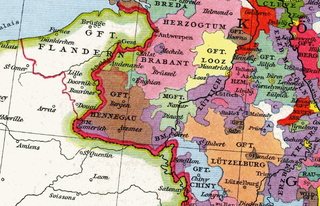Godfrey de Heinsberg (died 1395), Lord of Daelenbroeck, Count of Looz and Count of Chiny (1361-1362), son of John of Heinsberg, Lord of Daelenbroeck (brother of the preceding count Thierry de Heinsberg), son of Arnold V, Count of Looz and Chiny, and Catherine de Vroon.
The Counts of Chiny were part of the nobility of Lotharingia that ruled from the 9th to the 14th century in what is now part of Belgium. The County of Chiny was created in the early 10th century out of the ancient county of Ivois. The county now forms part of the province of Luxembourg in present-day Belgium. The county of Chiny included the present-day cantons of Virton, Etalle, Florenville, Neufchâteau, Montmédy and Carignan, as well as the castles of Warcq on the Meuse, which was built in 971 by Otto, ancestor of the later Counts of Chiny. There is a close relationship between the Counts of Chiny and the Counts of Looz, the Counts of Verdun and the Bishops of Verdun.
Thierry de Heinsberg , Count of Looz and Count of Chiny (1336-1361), son of Godefroy II, Lord of Heinsberg, son of Dietrich, Lord of Heinsberg, and Jeanne de Louvaine, and Matilda, daughter of Arnold V, Count of Looz and Chiny, and Marguerite Vianden.
Arnold V de Looz, was Count of Loon from 1279 to 1323 and Count of Chiny from 1299 to 1310. He was the son of John I, Count of Looz and Mathilde Jülich.
Upon the death of his uncle Thierry de Heinsberg in 1361, Godfrey claimed his estates and proclaimed himself Count of Looz and Chiny. However, Engelbert III of the Marck, Prince-Bishop of Liege, was far less merciful to Godfrey than to Thierry, and pursued the claims to the counties that Adolph of the Marck had negotiated with Louis IV the Younger in an agreement in 1190. This is interesting (but not surprising) in that Engelbert was the brother-in-law of Godfrey, having married Richardis of Jülich (d. 1360), sister of Godfrey’s wife Philippa.
Engelbert III von der Mark was the Archbishop-Elector of Cologne from 1364 until 1368 and the Prince-Bishop of Liège from 1345 until 1364.
Engelbert proclaimed the annexation of Looz and Chiny for the Chapter of St. Lambert in Liege on May 5, 1361, and his troops occupied the county from June 1361. On January 25, 1362, Godfrey sold the counties and their rights to Arnold of Rumigny, grandson of Arnold V, Count of Looz and Chiny. Arnold was destined to be the last of the Counts of Looz and Chiny.
Arnold VI de Rumigny, Count of Looz and Count of Chiny (1362–1364), son of William of Oreye, Lord of Rumigny, and Jeanne de Looz, daughter of Arnold V, Count of Loon and Chiny, and, Marguerite Vianden, Lady of Perwez and Grimbergen.
Godfrey was married in 1357 to Philippa of Jülich (d. 1390), daughter of William V, Duke of Jülich, and Joanna of Hainaut. The children of Godfrey and Joanna included:
William V, Duke of Jülich was a German nobleman. Some authors call him William I, because he was the first Duke of Jülich; the earlier Williams had been Count of Jülich. Other authors call the subject of this article "William VI"; they count the son and co-ruler of William IV as William V.
Joanna of Hainault (1315–1374) was a Duchess of Jülich by marriage to William V, Duke of Jülich. She was the third daughter of William I, Count of Hainaut, and Joanna of Valois. She was a younger sister of Philippa of Hainault, Queen of England, and Margaret II of Hainault.
- John II of Loon-Heinsberg (d. 1438), Seigneur of Heinsberg and Daelenbroeck, married first to Margareta van Gennep and second to Anna von Solms
- Godfrey, Canon of Utrecht
- Jeanne (d. 1415), married in 1375 to William VIII of Horn (d. 25 October 1415 at the Battle of Agincourt), son of William VII of Horn and Isabelle van Arkel
- Philippa, married first to Gérard de Tomber-Landskron and second to Gumprecht, Count of Neuenahr
- Catherine, married in 1389 to Gisbert de Buron.
John II ,, Lord of Jülich, Heinsberg and Löwenberg, son of Godfrey de Heinsberg, Count of Looz, and Philippa of Jülich, daughter of William V, Duke of Jülich, and Joanna of Hainaut. Although John was the first son of Godfrey, he did not inherit the countship of Looz, the title instead going to Arnold of Rumingy.

Utrecht is the fourth-largest city and a municipality of the Netherlands, capital and most populous city of the province of Utrecht. It is located in the eastern corner of the Randstad conurbation, and in the very centre of mainland Netherlands, and had a population of 345,080 in 2017.

The Battle of Agincourt was one of the greatest English victories in the Hundred Years' War. It took place on 25 October 1415 near Azincourt in the County of Saint-Pol, in northern France. England's unexpected victory against a numerically superior French army boosted English morale and prestige, crippled France, and started a new period in the war during which the English began enjoying great military successes.
In 1362, Arnold of Rumingy assumed the role of Count of Looz and Chiny,the last of a rich history of these counts.


